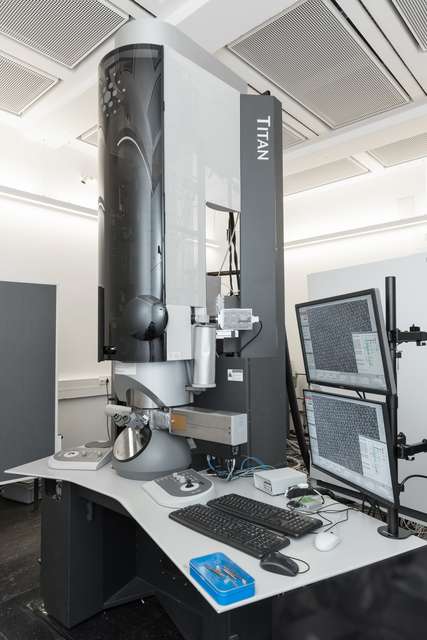FEI Titan 80-300 STEM (Titan S)
Jülich
The FEI Titan 80-300 STEM is a scanning transmission electron microscope equipped with a field emission electron gun, a three-condenser lens system, a monochromator unit, and a Cs probe corrector (CEOS), a post-column energy filter system (Gatan Tridiem 865 ER) as well as a Gatan 2k slow scan CCD system. Characterised by a STEM resolution of 80 pm at 300 kV, the instrument was one of the first of a small number of sub-ångström resolution scanning transmission electron microscopes in the world when commissioned in 2006.
Typical Applications and Limitations of Use
The FEI Titan 80-300 STEM allows a variety of advanced scanning transmission electron microscopy investigations to a wide range of materials. Techniques like electron energy loss spectroscopy (EELS), energy filtered transmission electron microscopy (EFTEM), high resolution scanning transmission electron microscopy (HRSTEM) with detectors for bright-field, annular dark-field, and high-angle annular dark field (HAADF) imaging, electron tomography (ET), and combinations of the previous techniques.
The FEI Titan 80-300 STEM is not intended for the investigation of aqueous, contaminated, ferromagnetic or organic samples without further discussions with both of the instruments officers and the ER-C general management.
Sample Environment
Apart from the special case of the utilisation of dedicated cooling or heating stages, the FEI Titan 80-300 STEM will allow samples to be investigated either under room temperature or liquid nitrogen cooling conditions at a vacuum level of about 10–8 mbar. Besides this standard setup, the sample environment can be adapted to various conditions, e.g. thermal treatment under vacuum or under gas atmosphere up to 1 bar using a MEMS-based closed-cell holder, or the application of external electric or magnetic fields to samples, making use of a wide portfolio of in situ TEM holders available at the ER-C.
Publications
Understanding and Controlling Nanoporosity Formation for Improving the Stability of Bimetallic Fuel Cell Catalysts
Gan L, Heggen M, O’Malley R, Theobald B, Strasser P - Nano Letters - 2013
Compositional segregation in shaped Pt alloy nanoparticles and their structural behaviour during electrocatalysis
Cui C, Gan L, Heggen M, Rudi S, Strasser P - Nature Materials - 2013
Core–Shell Compositional Fine Structures of Dealloyed PtxNi1–x Nanoparticles and Their Impact on Oxygen Reduction Catalysis
Gan L, Heggen M, Rudi S, Strasser P - Nano Letters - 2012
Plastic-deformation mechanism in complex solids
Heggen M, Houben L, Feuerbacher M - Nature Materials - 2010
Link: https://er-c.org/index.php/access/
